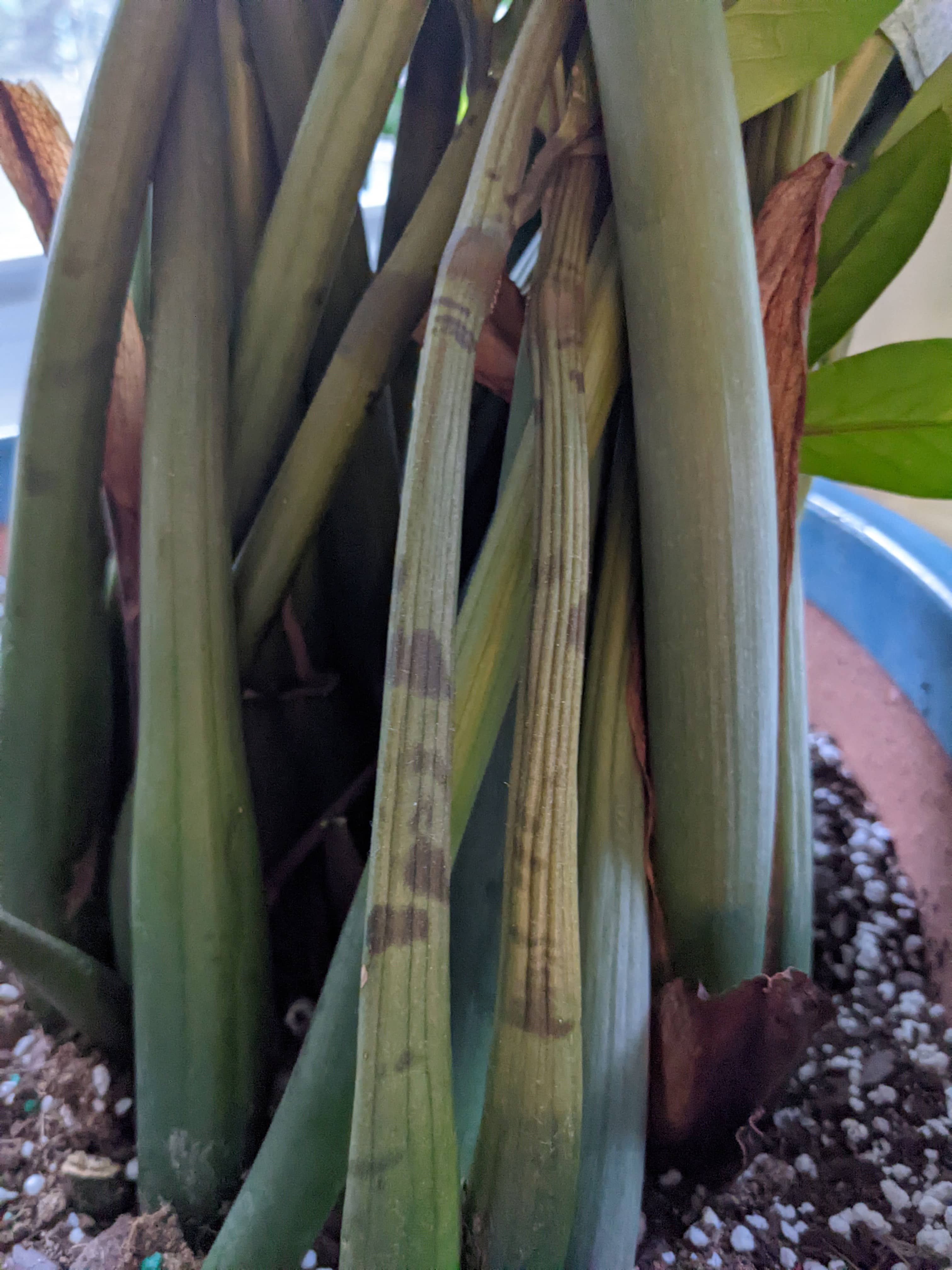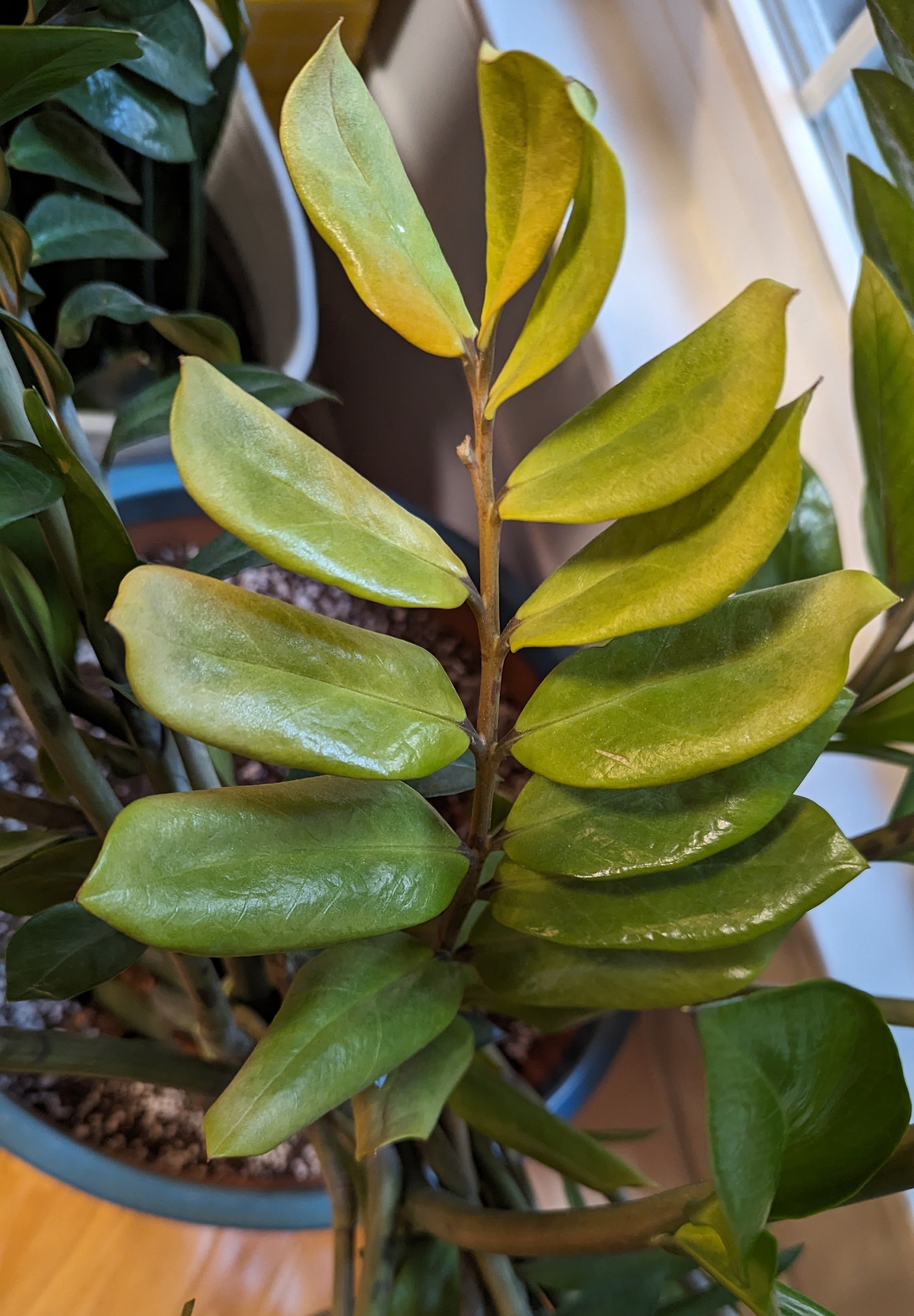Why is My ZZ Plant Turning Yellow
ZZ Plants are popular houseplants due to their ease of care. They sport glossy dark green leaves. Although ZZ Plants are considered easy to care for it can be to their detriment. When you’re advised not to water too much, or give it too much light that can lead you to ignore your ZZ Plant. Some times ZZ Plant leaves can turn yellow from improper care. Read on to learn some of the most common reasons for ZZ Plant leaves turning yellow and find out what you can about it.
Why Are My ZZ Plant Leaves Turning Yellowing?
Moisture Issues
Soil moisture mismanagement is usually the most likely culprit for ZZ Plant leaves turning yellow. Both over- and underwatering can cause ZZ Plant leaves to yellow. Below I’ll try to help you decipher which is your problem. In my experience the easiest way to tell if there is a water issue is to use a soil moisture meter. I use something simple like this soil moisture meter. While some people use their finger to assess soil moisture, I find that to be imprecise and also messy. If you question whether you have a moisture issue going on, it makes sense to be sure about what the problem is.
I have underwatered my own ZZ Plant. My excuse is thev it needs such infrequent watering that it it becomes easy to ignore your plant for too long. in part due to it needing such infrequent watering. I found it hard to track of the last time I watered without a calendar reminder, and therefore easier to neglect my ZZ Plant. One sign outside of yellowing leaves for underwatering is that the stems will wrinkle too. It’s a good idea to inspect the leaves and stems of your ZZ Plant in order spot the early signs of a problem. See the picture below of wrinkled ZZ stems.

Overwatered ZZ Plants will have wet or very moist soil. Leaves can also turn yellow from overwatering. ZZ Plants have plump stems and tuberous rhizomes that hold water, so they don’t need a lot. In addition to yellowing , overwatered leaves sometimes display brown splotches as well.
How to Fix Water Issues
In the scenario where you have been underwatering, you really just need to increase your watering in some manner. This can mean one of two things. Supply water more often than you were previously, or you can give a larger amount of water each time you water. It’s important to find a balance that works because you can easily flip the problem and start overwatering out of fear for underwatering. Unfortunately, the yellow leaves of ZZ Plant will not regain their color. You have two choices with the yellow leaves as well. They will brown, dry up, and fall off eventually. If you don’t like the look of them, you can also just pull or cut them off. If your whole stem has yellowing leaves, you may just want to trim back the whole stem, as leaves will not regrow on these stems.
One other thing to keep an eye on is whether the water absorbs in the soil or if it runs quickly out of the bottom of the pot. Some soil that has been severely underwatered can become hydrophobic, which means it can repel water instead of absorbing it. To combat this, you may need to bottom water your ZZ Plant, which means you need to stick your plant pot in a bowl or the sink with a few inches of water. Then allow soil and roots some time to soak up water from the base of the pot.
If you have overwatered you ZZ Plant, the fix will be more complicated. Carefully remove your ZZ Plant from its pot. This will allow the roots, rhizomes, and soil to dry out more quickly. The roots and rhizomes of an overwatered plant will be very tender and vulnerable. It’s important to be careful not to inflict damage and clean so you don’t introduce disease. Once the soil and roots have dried enough to handle, you should inspect the roots for rot. Root rot will look translucent brown rather than white and the roots will feel mushy. Root rot must be removed with a sterile sharp knife. You can repot your ZZ Plant after letting it dry and cutting away root rot.
Fertilizing Issues
Like moisture, fertilizer can be both over done and under done. If your leaves are turning yellow, it’s more likely to be a sign of underfertilization rather then over. ZZ Plants that are overfertilized are most likely to exhibit slow growth and maybe even wilting. An all purpose houseplant fertilizer will generally work well for a ZZ Plant. These all-purpose fertilizers have a balanced ratio of nitrogen, phosphorous, and potassium, or n-p-k, which you locate on most labels of plant fertilizers. Leaf yellowing may be a result of a lack of nitrogen or potassium. Nitrogen helps promote healthy foliage growth while potassium promotes overall plant health.

It’s a but difficult to tell if you have a fertilization issue just by sight. The visible symptoms of a fertilization issue generally show up all over the plant on multiple stems and leaves, and not in concentrated in a single spot. However, the best way to decipher if you have a fertilization issue and whether you have been over- or underfertilizing is to use soil rapitest. It allows you to test the ph and the levels of each of the three main nutrients, n-p-k, individually. There is no other way to be totally sure you have a nutrient issue, and if you have a lot of plants it’s a good investment.
How to Fix Fertilization Issues
An overfertilized ZZ Plant needs to be flushed with water to remove excess nutrients from the soil. You can do this by watering it a lot at one time. Make sure that water is flowing freely from the bottom of the pot through the drainage holes You can even removed the plant from its pot when flushing which allows it to dry out more quickly, but you also risk washing away a lot of soil doing this as well. Flushing a plant’s soil can be petty shocking, so don’t be surprised if it looks worse off short-term.
Underfertilized ZZ Plants are easier, you just need to fertilize them. A water-soluble or liquid fertilizer will provide the quickest absorption, which may be beneficial in the case of underfertilization. If you don’t know which nutrient your plant is deficient in, then you should stick with an all-purpose fertilizer that has the same or similar number in the n-p-k ratio. However, if you used a soil rapitest and you know that you have a nitrogen deficiency for example, then you can find fertilizers that have higher ratios of the nutrient you need. Always follow the directions on the label of your fertilizing product. Some fertilizers require dilution or that you water the plant beforehand, and not following these instructions can lead to fertilizer issues.
Pests Issues
Unfortunately, many pests like to attack ZZ Plants. Some common pests that attack the leaves causing them to yellow are aphids, scale/mealybugs, spider mites, and thrips. If you have a large enough infestation, the pests feeding on the leaves will ultimately destroy the leaves. Unlike water and fertilization issues, the yellowing due to pest damage is more distinct looking. Pest damage is small and speckled or spotty where the pests have fed. If you think you might have pests, immediately do a close visual inspection of your ZZ Plant and it’s surrounding plant neighbors as soon as possible. I like to use a flashlight to help look for pests. Always check the underside of the leaves because pests often hang out there.
How to Fix Pest Issues
If you see a plant pests, immediately quarantine your plant away from other uninfested plants.. It’s unbelievable how quickly they can spread. You must commit to multiple weeks of treatment to actually get rid of plant pests. First try to remove as many pests as you can see. Aphids, spider mites, and thirps can typically be removed by a strong spray in the shower or outside with a garden hose. Scale and mealybugs require manual removal because they have an armor-like shell that even a strong spray will not move. They are easy to pick or scrape off though.
After you have removed all the pests to can see, use an insecticide. There are organic pesticides, like neem oil, and inorganic ones, like insecticidal soap. Both work well. I have personally used neem oil on spider mite infested Rubber Tree with success. Even after you don’t see anymore pests you have to keep your plant quarantined. In fact, you may have to repeat removal and insecticide application every few days until you do not detect pests for over a week. The reason to wait a week is because of the pest lifecycle. Although you don’t see them, their eggs may still be there and that could result in a reinfestation your plant.
Hopefully, this helps explain why your ZZ Plant leaves are turning yellow and now you’re equipped with the knowledge to fix it. Have any questions? Post them in the Comments section below.
Add new comment